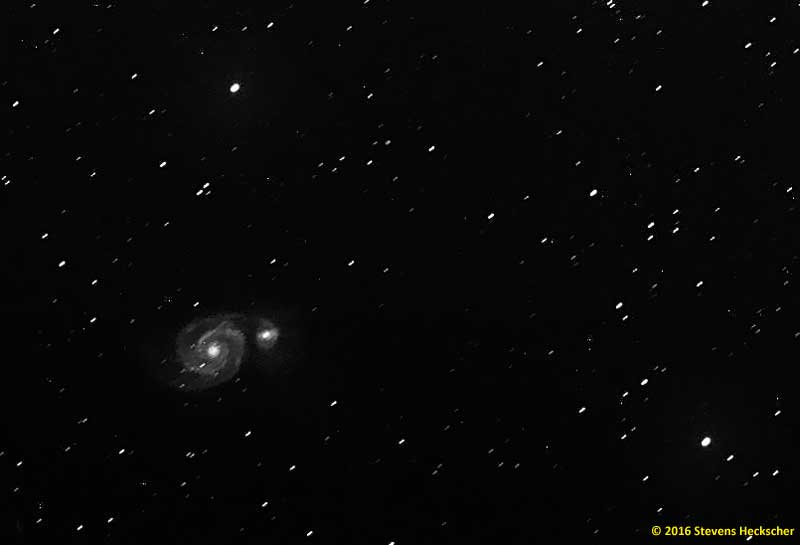Excerpts from Jim Conrad's
Naturalist Newsletter
from the July 17, 2016 Newsletter issued from Hacienda Chichen Resort beside Chichén Itzá Ruins; limestone bedrock; elevation ~39m (~128ft), N20.675°, W88.569°; central Yucatán state, MÉXICO
WHIRLPOOL GALAXY

A while back a family visited the Hacienda showing more than normal curiosity about local plants, animals and society. They all had PhDs or equivalent, wanted to know everything, and Stevens, the father in his 80s, was as enthusiastic and active as anyone. We've kept in touch, and this week Stevens sent me a picture he'd taken of the Whirlpool Galaxy, shown at the top of this page.
I might have guessed that the photo wasn't simply a snapshot taken in Stevens' backyard through an amateur's telescope. He wrote that he got the picture "... by accessing a telescope in Spain, via the internet, reserving telescope time, and setting the parameters remotely, then editing the resulting image and saving it. I can do this because I subscribed to an organization through Sky & Telescope Magazine, called the Zenith Club, which makes this service available to its members. Isn't that amazing?"
It's not in Stevens' character merely to express amazement; he must explain what's amazing. He continues:
".. if you look closely at the image I sent you, you will notice ... that the nearby stars are short streaks, oriented lower left to upper right. But the Whirlpool Galaxy is not streaked at all. Why? Because the Whirlpool is about a million times more distant from Earth than those stars. The streaking is due to the Earth's movement around the sun during the time exposure. The effect is identical to what you see from a fast car: objects nearby seem to whiz past, but distant objects seem almost stationary.
"Having understood that, you will now notice that, in the photograph, there are a few small white dots that are not streaked. Each one is surrounded by a small blur. These are galaxies that are far more distant than the Whirlpool (hence their apparent small size, and their lack of streaking). The white dots are the galactic centers, and the blurs are the arms, as with the Whirlpool, which you see close-up. I would not want to estimate the distances of those galaxies, but I am sure that they are almost inconceivably great. (The Whirlpool is 25 million light years distant from Earth.)
"Thus we are able tangibly to perceive something of the immensity of the universe and of its infinities."
At first I'd assumed that the streaking was caused by the Earth' rotation on its axis, not it's yearlong procession around the sun, but if that were the case the smaller spots -- the distant galaxies -- also would be streaked. Clearly the telescope in Spain is calibrated to compensate for the Earth's rotation, but not for its circling the Sun. Also, it's assumed that we understand that the largest spots are stars in our galaxy, the Milky Way, so when we see those distant, non-streaking galaxies, our line of vision first travels through a part of our own galaxy, then passes for unimaginable distances through empty space, before encountering whole other galaxies.
In Stevens' picture, notice the smaller blurred object at the right of the Whirlpool. That's another galaxy, NGC 5195 -- the Whirlpool is more technically known as NGC 5194, as well as M51a. The two galaxies are interacting in ways astronomers are very happy to study and theorize about.
This pair of galaxies is so relatively close to our Milky Way that it can be seen through binoculars, at least when the pair is highest in the night sky during the Northern Hemisphere's early hours of winter through the end of spring. They show up as tiny blurs. At other times they are too close to the horizon to be seen, or even below it. They're located in the little-known constellation Canes Venatici, just below the arcing handle of the Big Dipper -- the "tail" of the bear, Ursa Major. They're near the star forming the tip of the Big Dipper's handle. A map showing their exact position, with the interacting galaxies labeled as M51, can be accessed at https://en.wikipedia.org/wiki/Canes_Venatici
It's not known how many stars the Whirlpool Galaxy is home to, but when the galaxy's mass is calculated it's found to amount to about 160 billion times that of Earth's own star, the Sun. Still, the Whirlpool's size is only about 35% that of our own galaxy, the Milky Way.
More information about the Whirlpool Galaxy is found at https://en.wikipedia.org/wiki/Whirlpool_Galaxy